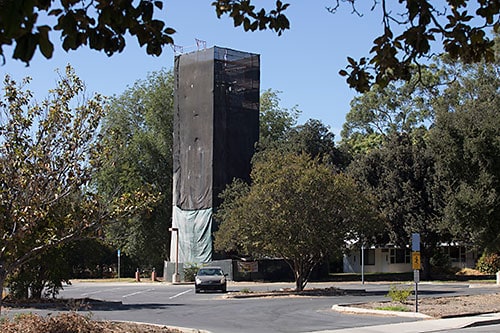Cell phone tower causes conflict for nearby residents

Michael Bright has been living at the Mountain Village Senior Apartments for years, but he’s concerned for his safety.
The reason, he said, is because of a cell phone tower being built at nearby St. Ambrose Episcopal Church. Mr. Bright, a cancer survivor, has health concerns about the tower, and also claims he didn’t receive notice about the tower from management.
“Living next door to that commotion for six months, I didn’t know what it was,” he said.
Construction began about a month ago and is well on its way to completion. The 60-foot high tower was designed to blend in with the church, employing a steeple-like design using the same brick construction as the church itself, according to the city.
The tower was approved in April 2017, according to Claremont Community Development Director Brad Johnson.
According to city code, property owners within a 300-foot radius of the new tower have to be notified, in case of concerns. But there’s nothing in the code about informing tenants or renters.
“I just think it’s [the property owners’] decision whether to share it with their tenants or not,” Mr. Johnson said. “Certainly if the property owner had an issue with it we would hear them out, take their input from it and modify if it was necessary.”
He noted that one other property owner in the 300-foot radius had also expressed concern about the tower.
Another resident, Kenneth Christensen, pleaded his case to the Claremont city council last Tuesday, saying he was worried about residents “who are already predisposed to sickness” falling ill from the feared effects of the tower.
“This could force many seniors, as well as disabled people, to move from their homes, and the nearest place available has a two-year waiting list,” he said.
Mr. Christensen also claimed he wasn’t notified about the tower, accusing landlords of “not seeming to care.”
When contacted, an employee of Mountain Village Senior Apartments refused to comment.
Rick Cota, executive director of facilities at Claremont Unified School District, expressed concern about the lack of notice, especially given the tower’s proximity to El Roble Intermediate School.
“It would have been good to have that notice to put it out to parents to ask, ‘Hey, do you have an issue of it being 400 yards away from school?’” he said.
The common courtesy, he said, was to let everyone in a neighborhood know about the tower, but also, “In this case, we didn’t get notice” from the city or Verizon.
Mr. Johnson speculated the school district wasn’t notified due to proximity.
“It could very well be they were outside the 300-foot radius,” he said.
The matter was brought to the attention of the city’s planning commission, Mr. Johnson said, in case they had any questions. The commission did not reach out to the city, he added. The tower’s construction was not on an agenda and did not go through formal commission review.
The American Cancer Society reported on its website, there is “very little evidence” to support the idea that cell phone towers cause cancer. This is due to radiofrequency (RF) waves being “relatively low,” and not enough to break chemical bonds in DNA, as well as RF waves not being concentrated enough to affect individual cells.
“The amount of exposure from living near a cell phone tower is typically many times lower than the exposure from using a cell phone,” according to the American Cancer Society.
But Mr. Bright cites a German study, which claims that cancer rates were higher in residents who lived near two cell towers for 10 years. In another study Mr. Bright cited, milk yield in cows dropped when they were moved closer to cell towers.
“America is not paying attention to this,” Mr. Bright said. “Claremont, I thought, was somewhat awake environmentally.”
RF energy is regulated by the Federal Communications Commission (FCC), which sets standards for acceptable human exposure, the city said. Federal law specifically prohibits local governments like Claremont from denying applications for a structure like a cell tower based on health concerns.
Mr. Bright notes that FCC regulations haven’t been updated since 1996, when there were around 44 million cell phones in the US, as opposed to around 300 million today.
Rev. Brian Baker, interim rector at St. Ambrose, said he was not in charge when the deal was reached with Verizon, but said the church followed the letter of the law.
“In this process, we were careful of abiding by all local and federal government regulations,” he said, adding there were no safety concerns of which the church was aware.
Mr. Baker didn’t know the dollar amount of the church’s contract with Verizon. Mr. Johnson said cellular companies pay a monthly rent of $2,000 to $3,000 for towers located on city-owned properties.
Mr. Baker said the contract with St. Ambrose was a “boilerplate,” and said it has become common practice for churches to contract with cell phone companies to build towers, due to the steeples’ height and churches tending to be on higher ground.
“This is a part of a much bigger trend in the US,” he said.
Mr. Bright, in an email, took issue with the fact the tower is desiged to look like a church steeple.
“I find this very inappropriate that the city and Verizon would use a church to deceive the public,” he wrote.
Around 90 days after tower operations commence, the city will be provided a preliminary report prepared by an engineer that shows whether or not the tower is confirming to safety standards, the city said.
—Matthew Bramlett
news@claremont-courier.com










0 Comments